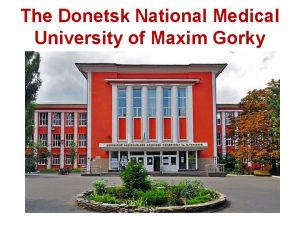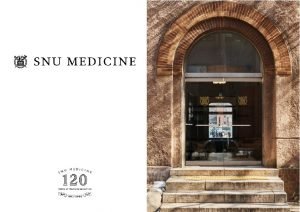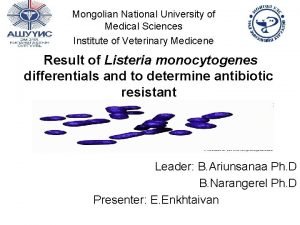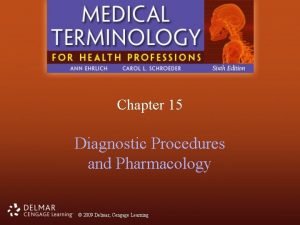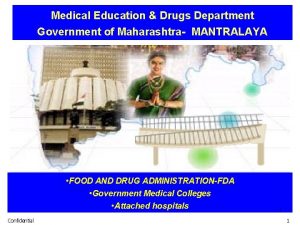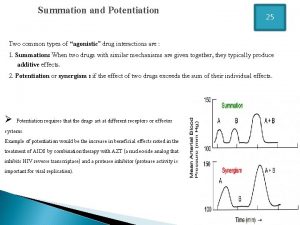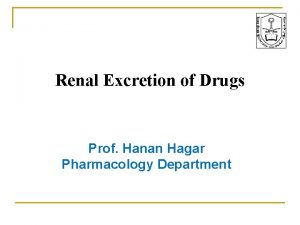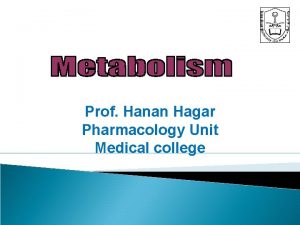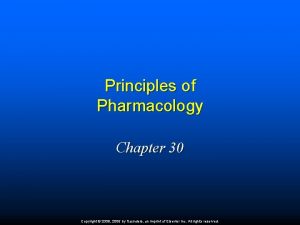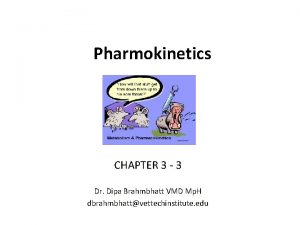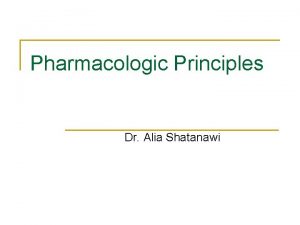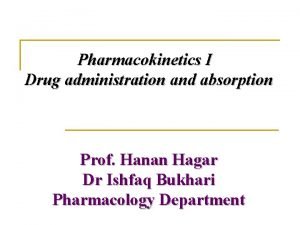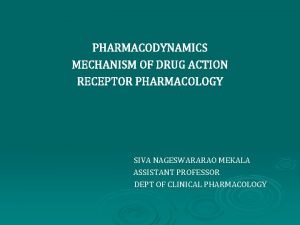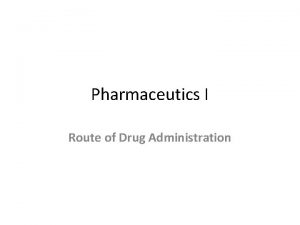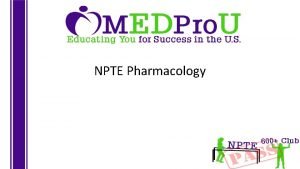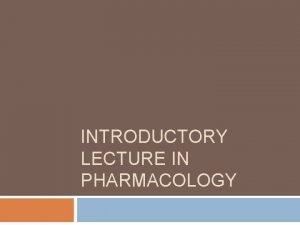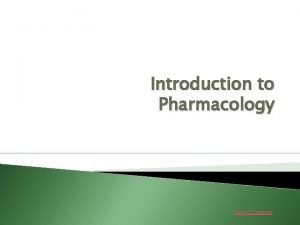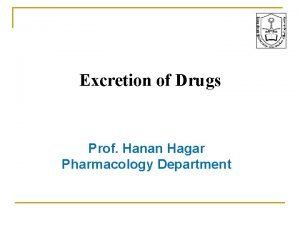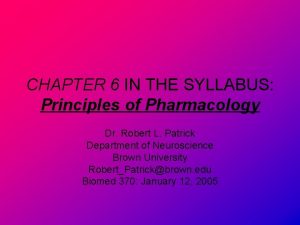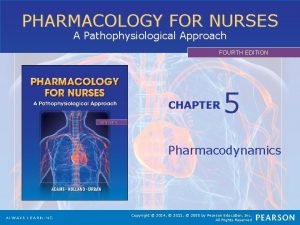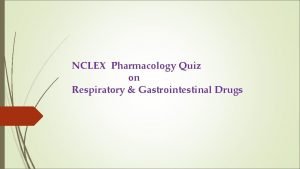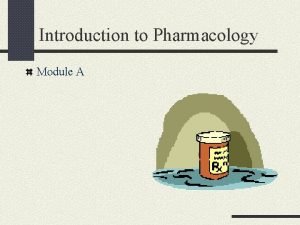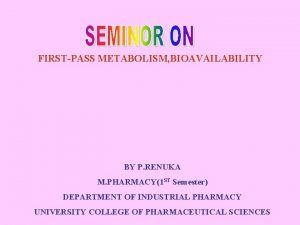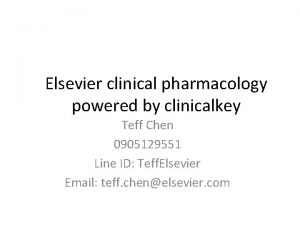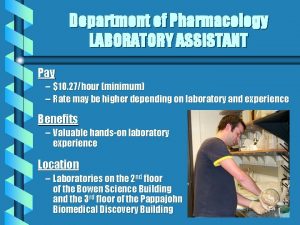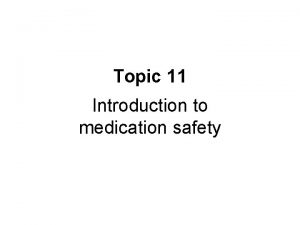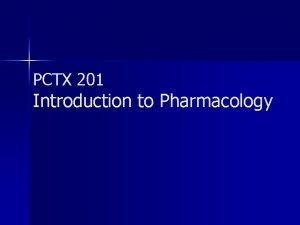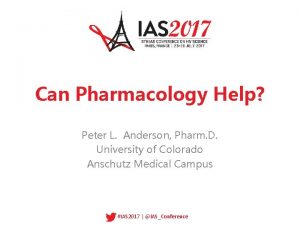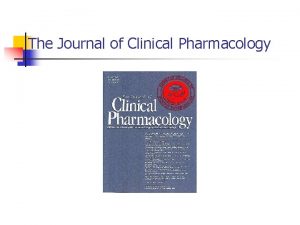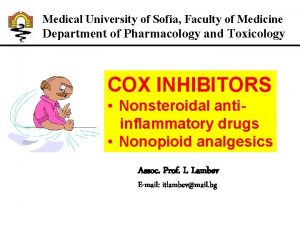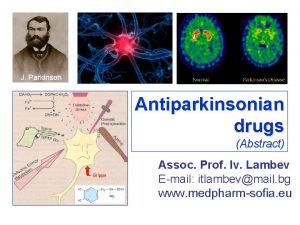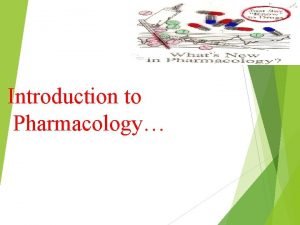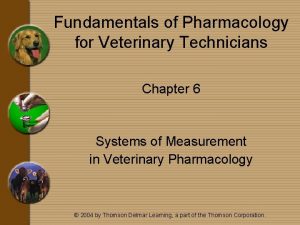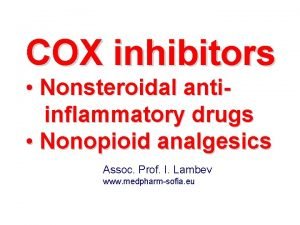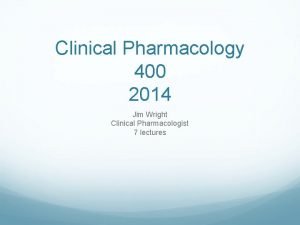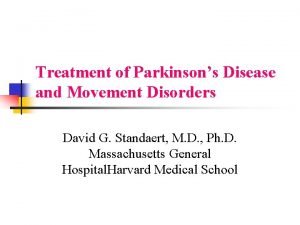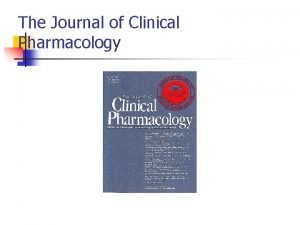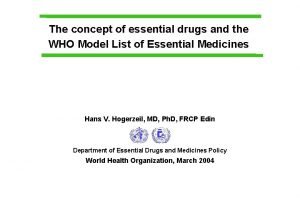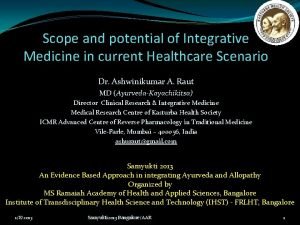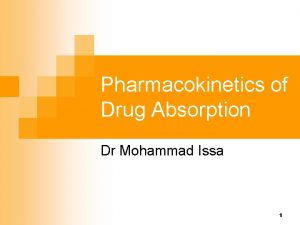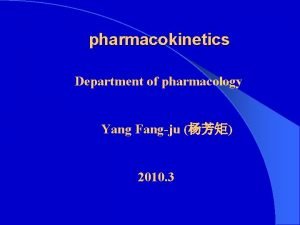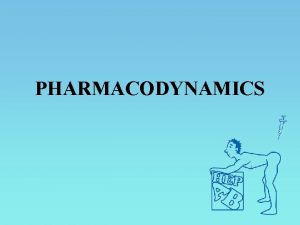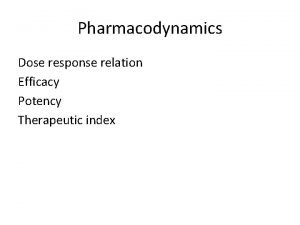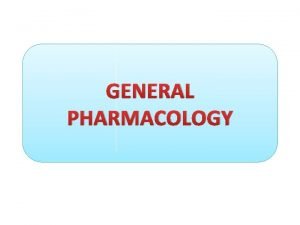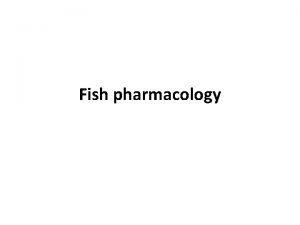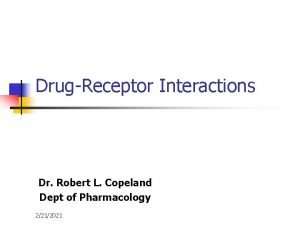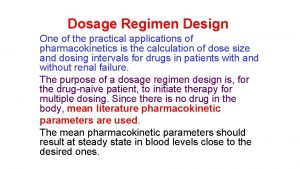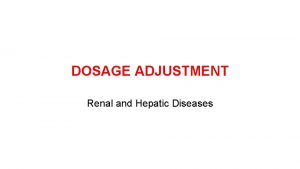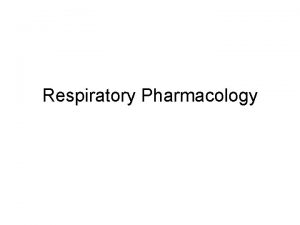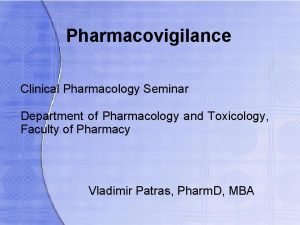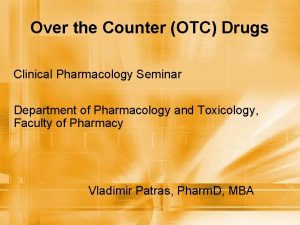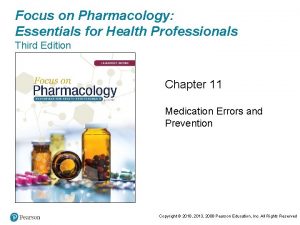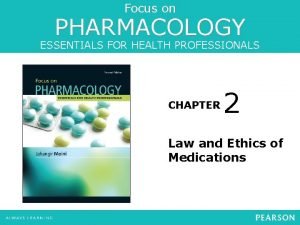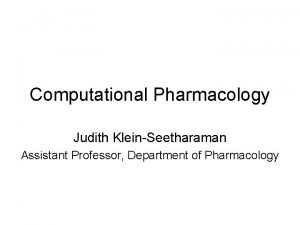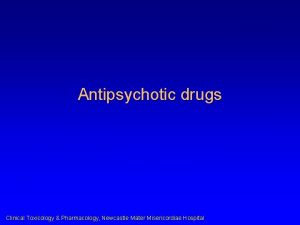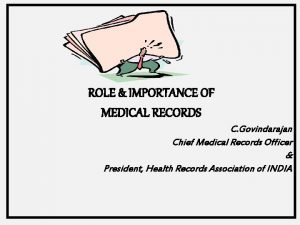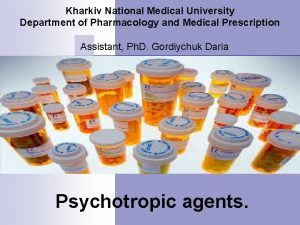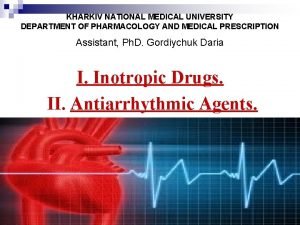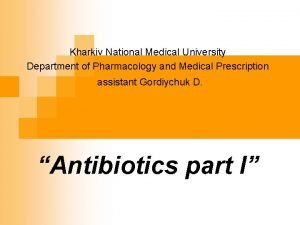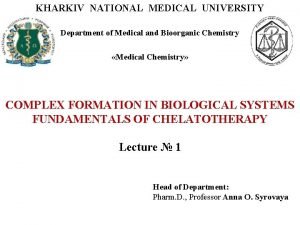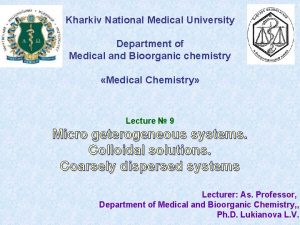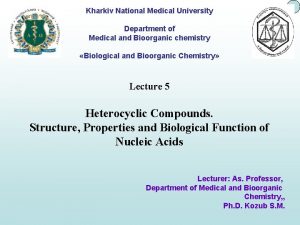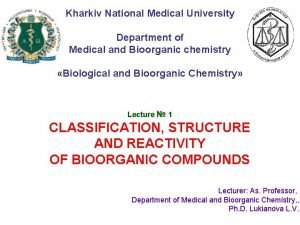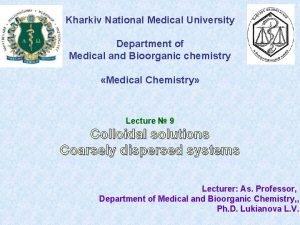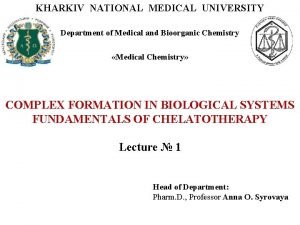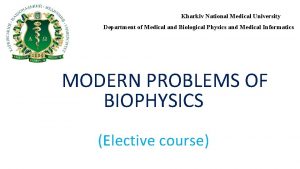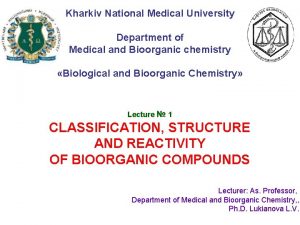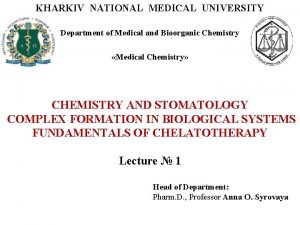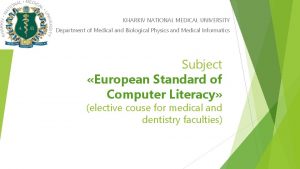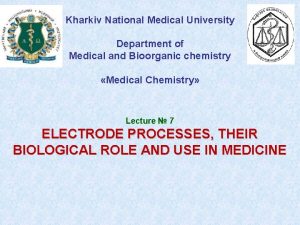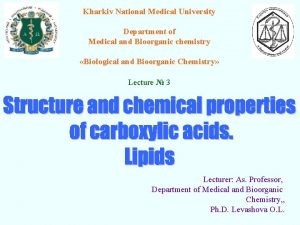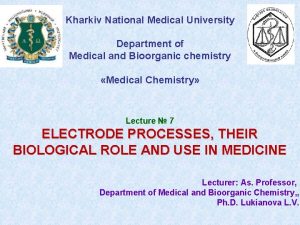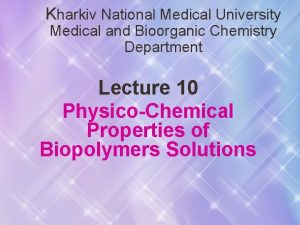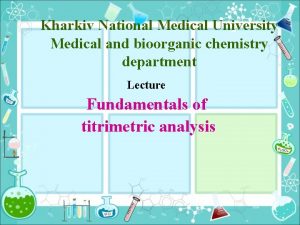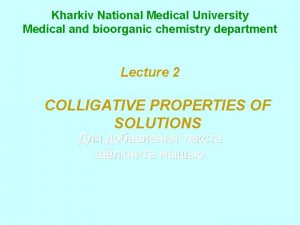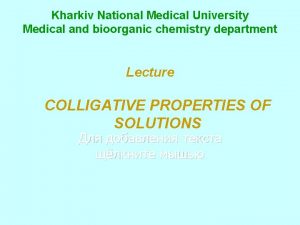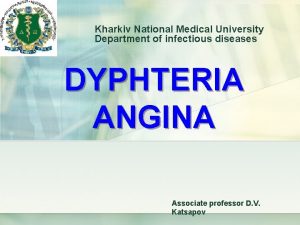Kharkiv National Medical University Department of Pharmacology and





































































- Slides: 69

Kharkiv National Medical University Department of Pharmacology and Medical Prescription assistant Gordiychuk D. “Antibiotics Part II. Antimycobacteria agents. ”

Plan of lecture: Pharmacology of Tetracyclines, Aminoglycosides, Macrolides and Azalides, Chloramphenicoles, Rifampicine, Lincosamides. n Pharmacology of Antimycobacterial agents. n

Antibiotics ("Anti" – against, "bios" - life) n Antibiotics - a substance produced by microorganisms, or produced from vegetable and animal tissues, and their semisynthetic and synthetic analogs selectively inhibit the viability of microorganisms sensitive to them. Importance of Antibiotics: n The elimination of the global crisis of infectious diseases (cholera, plague, dysentery). Effective at the dangerous diseases (sepsis, meningitis, peritonitis, pneumonia). ≈ 20 million people die each year from infectious diseases. 1/3 of all hospital patients are treated with antibiotics. Over the past 20 years there were 20 new infectious diseases (Legionnaires' disease, hairycell leukemia, hemorrhagic fever and others). Unconventional use of antibiotics: peptic ulcer, asthma, myocardial infarction, atherosclerosis. In breadth of application group of antibiotics ranked the first place in the world. Today, there is no person at least who did not use antibiotics. There is no country that doesn’t threat of epidemics and pandemics. n n n n

Bacterial cell Cytoplasmic membrane Cell wall Nuclear apparatus Ribosomes Violation of the cell wall synthesis. B-lactams Glycopeptide Violation of cytoplasmic membranes permeability. Polymyxins Gramicidin Antifungal Violation of RNA synthesis Rifampicin Violation of protein synthesis at the level of ribosomes. Tetracyclines Chloramphenicols Lincosamides Macrolides Azalides Aminoglycosides Fuzidinum

Antimicrobial drugs have also been classified broadly into: 1. bacteriostatic, i. e. those that act primarily by arresting bacterial multiplication, such as tetracyclines, chloramphenicol, macrolides, lincosamides. 2. bacteriocidal, i. e. those which act primarily by killing bacteria, such as penicillins, monobactams, carbapenems, cephalosporins, aminoglycosides, rifampicin etc.

Aminoglycosides (Classification) 1 GENERATION n Neomycin n Streptomycin n Kanamycin n Monomycin 2 GENERATION n Gentamycin n Tobramycin n Netilmycin 3 GENERATION n Amikacin

Mechanism of Aminoglycosides action n n n Aminoglycosides are bactericidal antibiotics. The antibacterial properties of aminoglycosides is a result of inhibition of bacterial protein synthesis through irreversible binding to the 30 S-bacterial ribosome. However other antibiotics that inhibit the synthesis of proteins (such as tetracycline) are not bactericidal. Recent experimental studies show that the initial site of action is the outer bacterial membrane. The cationic antibiotic molecules create fissures in the outer cell membrane, resulting in leakage of intracellular contents, enhanced antibiotic uptake and creation of defective bacterial proteins. This rapid action at the outer membrane is responsible for the bactericidal activity. Energy is needed for aminoglycoside uptake into the bacterial cell. Anaerobes have less energy available for this uptake, so aminoglycosides are less active against anaerobes.

Spectrum of aminoglycosides Staphylococci, n Streptococci, n Escerichia, n Salmonella, n Shigella, n Vibrio cholerae, n Klebsiella pneumonica n n Aerobacter, Neiseria, n Brucella, n Proteus, n Yersinia pestis, n Serratia, n Pseudomonos aeruginosa. n

Spectrum of aminoglycosides Some of the drugs are effective against Mycobacteria tuberculosis (Streptomycin, Kanamycin, and Amikacin). n Aminoglycosides are effective only against aerobic organisms, since anaerobes lack the oxygen-requiring transport system. n Drugs II and III generation potentiate the action of penicillins and cephalosporins. n

Clinical uses of AMINOGLYCOSIDES n n n n n Respiratory infections, Subacute bacterial endocarditis, Plague Tularemia Meningitis (Gentamycin) Urinary tract infections Osteomyelitis Lung abcesses Septic processes caused by Pseudomonas aeruginosa Tuberculosis (Streptomycin, Kanamycin, and Amikacin).

Side effects of AMINOGLYCOSIDES n n n n Ototoxicity Vestibulotoxicity (nausea, vomiting, vertigo, nistagmus) Nephrotoxicity Neuromuscular blockade (reduction of Ca 2+ and Ach release, especially neomycin and streptomycin) Allergic reactions Superinfection Imunosupression - Contraindicated introduction of aminoglycosides in the same syringe with penicillins, polymyxin B, cephalosporins - possible physical and chemical incompatibility!!!


Tetracyclines Natural Semisynthetic Tetracycline Methacycline Doxacycline (Vibramycine)

Tetracyclines are also classified as: (1) short-acting (chlortetracycline, oxytetracycline) based on plasma t 1/2 of 6– 8 h; (2) intermediate acting (demeclocycline and methacycline) – t 1/2 12 h; (3) long-acting (doxycycline and minocycline) with plasma t 1/2 16– 18 h. (1)The almost complete absorption and slow (2)excretion of DOXYCYCLINE AND MINOCYCLINE (3)ALLOW FOR ONCE-DAILY DOSING.

Mechanism of TETRACYCLINE action Penetration of antibiotic into susceptible microorganisms is mediated by transport protein; n On penetration the drug is binding to the 30 S subunit of the bacterial ribosome; n It results in inhibition of bacterial protein synthesis. n

Spectrum of Tetracyclines n n n n Cocci; Gram-positive bacilli: n n Clostridia, n listeria, n corynebacteria, B. anthracis; Gram-negative bacilli: n n H. ducreyi n Vibrio cholerae, n Yersinia pestis, n Y. enterocolitica, Campylobacter, n H. pylori Brucella Pasterella multocida, F. tularensis anaerobes; spirochetes, T. pallidum and Borrelia; rickettsiae (typhus etc. ) chlamydiae. Moderately sensitive: Actinomyces. Entomoeba histolitica (at high concentrations), Malarial Plasmodium

Exclusion of spectrum Tetracyclines do not inhibit: n Pseudomonas aeruginosa and Mycobacterium tuberculosis. n Many staphylococci, steptococci, enterococci and enterobacteria are now resistant to these antibiotics!!!

Resistance n n Because many strains of the following groups of Gr+ microorganisms [Streptococcus pyogenes, Streptococcus pneumoniae, Enterococcus group (Streptococcus faecalis and Streptococcus faecium), Alpha-hemolytic Streptococci (viridans group); other microorganisms Chlamydia psittaci] have been shown to be resistant to Tetracycline, culture and susceptibility testing are recommended. Up to 44 % of strains of Streptococcus pyogenes and 74 % of Streptococcus faecalis are resistant to Tetracycline drugs. Therefore, Tetracyclines should not be used for streptococcal disease unless the organisms have been demonstrated to be susceptible. Because of resistance to Tetracyclines, testing of susceptibility is recommended in infections caused by: Escherichia coli, Klebsiella species, Enterobacter aerogenes, Shigella species.

Clinical uses of TETRACYCLINES n n n n Empirical therapy Chlamydial urethritis and endocervicites Atypical pneumonia caused by Mycoplasma Cholera Brucellosis Plauge Relapsing fever Rickettsial infections

Clinical uses of TETRACYCLINES (second choice) n n n n n Tetanus Antrax Actinomycosis Tularemia Syphilis Amebiasis Chloroquin resistant malarial P. Falciparum Acne vulgaris Legionnaires' disease

Side effects of TETRACYCLINES n n n n GIT: anorexia, nausea, epigastric distress, vomiting, diarrhea, glossitis, hypertrophy of tongue papillae (black hairy tongue), dysphagia, enterocolitis, pancreatitis, dysbacteriosis; Hepatotoxicity, steatosis; Teeth: disturbances of teeth growth, discoloration of teeth, enamel hypoplasia; Disturbances of bones growth; Pseudotumor syndrome (rare): severe headache and vision problems due to dangerous secondary intracranial hypertension; Vertigo; Phototoxicity (risk of sunburn); Catabolic effect.

Side effects of tetracyclines (cont. ) n n n n Skin: maculopapular and erythematous rashes. Exfoliative dermatitis has been reported but is uncommon. Onycholysis and discoloration of the nails have been reported rarely. They may increase muscle weakness in myasthenia gravis and exacerbate systemic lupus erythematosus. Other: bulging fontanels in infants; Blood: hemolytic anemia, thrombocytopenia, thrombocytopenic purpura, neutropenia and eosinophilia have been reported; Superinfection, candidiasis, vitamin B deficiency, hyperbilirubinemia.

Tetracycline teeth Phototoxic Sunburn after Doxycycline intake

Contraindications Pregnancy or lactation, n Children before 8 years old, n Hepatic insufficiency, n Renal insufficiency, n Hypersensitivity to tetracyclines. n

MACROLIDES and AZALIDES CLASSIFICATION I GENERATION III GENERATION (AZALIDES) 1. Erithromycin 2. Spiramycin 3. Josamycin 4. Midecamycin 5. Roxithromycin 9. Azithromycin 6. Clarithromycin (Summamed) 7. Flurithromycin 8. Dirithromycin The combination of macrolides with tetracyclines and other drugs. 10. Oletetrine 11. Zinerite

MACROLIDES mechanism of action: Binds with 5 OSsubunit of microbial ribosomes and inhibit RNA and protein synthesis in the bacterial cell.

MACROLIDES SPECTRUM WIDE SPECTRUM: GR + and GR- cocci, bacillus, intra-cellular organisms. • Staphylococci, • Streptococci, • Gonococci, • Anaerobic cocci, • Enterobacteriaceae • Strains of Pseudomonas, H. influenzae, Campylobacter, Helicobacter, Chlamydia, Ligionella, Bordetella, M. pneumonia, P. carinii, T. gondii, M. avium complex. Resistant to MACROLIDES ARE MOST OF Grbacterias!!!

Indications for MACROLIDES • Infection of the upper and lower respiratory tract (acute bronchitis, exacerbation of chronic bronchitis, acquired pneumonia). • ENT infections (acute otitis, tonsillitis, tonzilofaringit). • Gynecological infections. • Skin and soft tissue infection (pyoderma, boils). • Toxoplasmosis, mycobacteriosis of HIV infected. • Ophthalmic infections, • Diphtheria, • Leprosy, • Cystic fibrosis. • Syphilis, prostatitis, urethritis, chlamydia, etc.

FEATURES of MACROLIDES n n n Bacteriostatic effect mainly against GR+ bacteria (streptococci, staphylococci). Activity against intracellular bacteria (chlamydia, mycoplasma, legionella). One of the least toxic antibiotics. Well absorbed from the gastrointestinal tract, acidstable, are able to consentrate in the inflammation area. Bioavailability greater than that of tetracyclines (well penetrate into tissues and cells with creation of high concentration). Inductors of microsomal liver enzymes.

Adverse reactions of MACROLIDES. Cross-sensitivity, n Dyspeptic disorders, n Cholestasis, n Reversible ototoxicity, n Ventricular tachycardia, n Cross-resistance, n Embryonic and foetotoxic effects (clarithromycin). n

Lincosamides Natural Lincomycin Semisynthetic Clindamycin (Dalacin C) • Mechanism of action: Inhibition of microbial cell proteins synthesis (similar to macrolides). • Mostly bacteriostatic action type (high conc. - bactericidal). • The narrow spectrum: mostly Gr + cocci. • Able to accumulate in bone and joints!!! • Rapid development of resistance. • No cross-sensitivity with β-lactams.

Lincosamides Indications: • As a reserve antistaphylococcal drugs in tonzillofaringitis, pneumonia, infections of the skin, soft tissues, bones, joints. Side effects: • Severe pseudomembranous colitis (ulceration, perforation of the intestine, peritonitis). • Treatment of colitis - vancomycin or metronidazole, detoxification therapy!!!!

Chloramphenicol (Levomycetin) n n Chloramphenicol palmitate Chloramphenicol succinate Spectrum is very broad, much resembling that of tetracycline, like the last it is not active against Pseudomonas aeruginosa. n But in contrast to tetracyclines it does not act on Chlamydiae or Enterobacter species. n Chloramphenicol is the most toxic antibiotic!!! n

Mechanism of CHLORAMPHENICOL action Chloramphenicol binds to a ribosome on the 50 S subunit, which is responsible for catalyzing the formation of bonds between amino acids, preventing the bacteria from linking amino acids together. n Chloramphenicol is able to halt the production of bacterial proteins, which keeps the bacteria from replicating and growing. This brings about bacteriostatic effect. n

Indications for CHLORAMPHENICOL n n Meningitis: !!!Drug is excellent BBB penetrating!!! Staphylococcal brain abscesses (the first choice). Typhoid fever, formerly chloramphenicol was the drug of first choice for typhoid, but now it is seldom used because of multiple drug-resistance of Salmonella typhi. Anaerobic infections (Bact. fragilis). Chloramphenicol may be used as a second choice agent in the treatment : n Cholera (tetracycline-resistant), n Brucellosis, n Rickettsial infections.

Indications Because of its excellent BBB penetration (far superior to any of the cephalosporins), chloramphenicol remains the first choice treatment for staphylococcal brain abscesses. n It is also useful in the treatment of brain abscesses due to mixed organisms or when the causative organism is not known. n

Indications. Chloramphenicol is active against the three main bacterial causes of meningitis: Neisseria meningitidis, Streptococcus pneumoniae and Haemophilus influenzae. In the West, chloramphenicol remains the drug of choice in the treatment of meningitis in patients with severe penicillin or cephalosporin and GPs allergy are recommended to carry intravenous chloramphenicol in their bag. n In low income countries, the WHO recommend that oily chloramphenicol be used first-line to treat meningitis. n

Chloramphenicol side effects. Aplastic anaemia is the most serious side effect of chloramphenicol, it is rare and is generally fatal. It usually occurs weeks or months after chloramphenicol treatment has been stopped. n Bone marrow suppression, as a direct toxic effect of Chloramphenicol on human mitochondria. It manifests first as a fall in hemoglobin levels; this anaemia is fully reversible once the drug is stopped and does not predict future development of aplastic anaemia. n Increased risk of childhood leukemia. n

Chloramphenicol side effects. Gray baby syndrome in intravenous use of chloramphenicol. n This causes several adverse effects, including hypotension and cyanosis. The condition can be prevented by using the drug at the recommended doses, and monitoring blood levels. n

CHLORAMPHENICOL side effects. • Newborn infants lack an effective glucuronic acid conjugation mechanism for the degradation and detoxification of chloramphenicol. • Consequently, when infants are given dosages above 50 mg/kg/d, the drug may accumulate, resulting in the gray baby syndrome, with vomiting, flaccidity, hypothermia, gray color, shock, and collapse. • To avoid this toxic effect, chloramphenicol should be used with caution in infants and the dosage limited to 50 mg/kg/d or less (during the first week of life) in full-term infants.

• Chloramphenicol inhibits hepatic microsomal enzymes that metabolize phenytoin and warfarin.

NB! Chloramphenicol should not be used for infections treatable by other safer antimicrobials!!!! n

Rifampicin. Rifamycin n Rifampicin n Rifabutin n Rifaximin n Mechanism of action: incorporation into DNA spiral, inhibition of DNA-dependent RNA-polymerase → inhibition of replication and transcription in microorganisms. Spectrum of action: wide, Mycobacterium tuberculosis, leprosy. Bactericidal. Indications: tuberculosis, leprosy, infections caused by multidrugresistant pathogens. Side effects: allergic reactions of heavy genesis, manifested by liver damage; flu-like syndrome, hemolytic anemia.

Antitubercular drugs.

TUBERCULOSIS (TB) n n n It is an infectious disease caused by various strains of mycobacteria, usually Mycobacterium tuberculosis. Typical localization - the lungs, but disease can also affect other parts of the body. It is spread through the air when people who have an active TB infection cough, sneeze, or otherwise transmit respiratory fluids through the air.

TUBERCULOSIS (TB) n n n The classic symptoms of active TB infection are: a chronic cough with blood-tinged sputum, fever, chills, night sweats, loss of appetite, weight loss, fatigue. Diagnosis of active TB relies on radiology (commonly chest X-rays), as well as microscopic examination and microbiological culture of body fluids. Diagnosis of latent TB relies on the tuberculin skin test (TST) and/or blood tests.

Spread of tuberculosis in the world In 2003 tuberculosis, affected 8. 7 million people. Most of these people lived in Asia and Africa, a small proportion were in Europe and in America. n In India near 2 million people develop active form of disease. n About 0, 5 million die of TB every year in this country. n

Spread of tuberculosis in the world

Mycobacterium tuberculosis n n n n Mycobacteria are slowly growing microorganism and thus relatively resistant to chemotherapeutic agents. Some of mycobacterium cells can be dormant and completely resistant to many drugs. Mycobacterial cell wall is impermeable to many agents. Mycobacteria may reside inside the macrophages, being inaccessible to the drugs poorly penetrating into macrophages. Mycobacteria is highly resistant in environment. Mycobacteria are capable of developing resistance to any single drug. To delay the development of resistance combination of several drugs are used in the treatment of tuberculosis. The response of mycobacterial infection to chemotherapy is slow, the treatment is long lasting.

Classification of anti-TB drugs (according to antitubercular efficacy) A. (The most effective) n Ethionamide (ET) n Cycloserine (C) n Isoniazid (INH) n Capreomycin n Rifampicin ( R) n Levofloxacin B. (Effective) C. (Less Effective) n Streptomycin (S) n Paraaminosalicylic Acid ( PAS) n Pyrazinamide (Z) n Thiacetazone (T) n Ethambutol (E) n Kanamycin (K)

Classification of anti-TB drugs (according to clinical uses) A drug may be considered as second-line instead of first-line for one of three possible reasons: it may be less effective than the firstline drugs (e. g. , p-aminosalicylic acid); or it may have toxic side-effects (e. g. , cycloserine); or it may be effective, but unavailable in many developing countries (e. g. , fluoroquinolones) n The third line drugs include drugs that may be useful, but have doubtful or unproven efficacy. n

Classification of anti-TB drugs n n n n n First line drugs for tuberculosis Isoniazid, Rifampicin, Ethambutol Pyrizanamide. Streptomycin. Second line drugs Amikacin, Kanamycin. Capreomycin. Ciprofloxacin, Levofloxacin, Moxifloxacin Ethionamide, Prothionamide n Cycloserine n Para aminosalicylic acid Third line drugs for tuberculosis n Rifabutin n Macrolides like clarythromycin n Linezolid n Thioacetazone n Vitamin D n Thioridazine n


Isoniazid is the hydralazide of isonicotinic acid. n It inhibits synthesis of mycolic acids, which are essential components of mycobacterial cell wall. n Effect tuberculocidal. n It acts on extracellular as well as on the intracelular mycobacteria. n

Pharmacokinetics of isoniazid Isoniazid is rapidly and almost completely absorbed, and peak blood levels are reached in about 1 to 2 hours. n Bioavailability is reduced when isoniazid is administered with food. n It diffuses readily into all body fluids (including cerebrospinal, pleural, and ascitic), tissues, organs, and excreta (saliva, sputum and feces). n The drug also passes through the placental barrier and into milk in concentrations comparable to those in the plasma. n Isoniazid is <10% bound to plasma proteins. n

Pharmacokinetics of isoniazid Isoniazid is metabolized by the liver mainly by acetylation and dehydrazination. n The N-acetylhydrazine metabolite is responsible for the hepatotoxic effects seen in patients treated with isoniazid. n The rate of acetylation is genetically determined. n Slow acetylation may lead to higher blood concentrations with chronic administration of the drug, with an increased risk of toxicity. n Isoniazid and its metabolites are excreted in the urine with 75 to 95% of the dose excreted in 24 hours. n

Clinical use Used in conjunction with other antituberculosis agents in the treatment of pulmonary and extrapulmonary tuberculosis. n Used alone in the prophylaxis of tuberculosis. n

Side effects of Isoniazid n n n n Peripheral neuropathy (occurs frequently ) Hepatitis has been reported in less than 5% of patients. Jaundice have rarely been reported. Hypersensitivity Isoniazid-induced lupus-like reactions Psychosis, depression, and aggression have been rarely reported with isoniazid therapy. Exacerbations of preexisting schizophrenia. G. I. T. side effects include nausea, vomiting, and epigastric distress. A few cases of pancreatitis have been reported.

Pharmacokinetics of RIFAMPICIN It is easily absorbed from the GIT n Distribution of the drug is high throughout the body. It reaches effective concentrations in many organs and body fluids, including the CSF. n About 60% to 90% of the drug is bound to plasma proteins. n It is metabolized by deacetylation, but metabolite is active antimicrobial. n It is eliminated with urine (30%) and about 60% to 65% is excreted through the feces. n

Rifampicin (side effects) n n n n Hepatotoxic - hepatitis, liver failure in severe cases. Respiratory – breathlessness. Cutaneous - flushing, pruritus, rash, redness and watering of eyes. Abdominal - nausea, vomiting, abdominal cramps with or without diarrhea. Flu-like symptoms - chills, fever, headache. Arthralgia, and malaise. Rifampin has good penetration into the brain, this may directly explain some malaise and dysphoria in a minority of users. Red staining of urine and other body fluids.

Pyrazinamide n n n Pyrazinamide is derivative of INH like isoniazid. It is more active in acidic medium. More tuberculocidal to intracellularly located mycobacteria. It is well absorbed from the GIT. It is widely distributed in body tissues and fluids including the liver, lungs and cerebrospinal fluid (CSF). It is hydrolyzed in the liver to its major active metabolite, pyrazinoic acid. Pyrazinamide may be bacteriostatic or bactericidal against Mycobacterium tuberculosis depending on the concentration of the drug attained at the site of infection.

Pyrazinamide Indications: Pyrazinamide is indicated for the initial treatment of active tuberculosis in adults and children. n It should only be used in conjunction with other effective antituberculous agents. n Side effects: n Hyperuricemia, n acute gouty arthritis, n fever, n loss of appetite, nausea and vomiting, n yellowish discoloration of the skin and eyes. n

Ethionamide n n n Minimum inhibitory concentration (MIC) against M. tuberculosis (H 37 Rv): 0. 25 microgram/ml. Ethionamide may be bacteriostatic or bactericidal in action, depending on the concentration of the drug attained at the site of infection and the susceptibility of the infecting organism. The exact MECHANISM OF ACTION of ETHIONAMIDE has not been fully elucidated, but the drug appears to inhibit peptide synthesis in susceptible organisms. Antimicrobial spectrum of Ethionamide comprises M. tuberculosis, M. bovis and M. Segmatis. Ethionamide is structurally similar to methimazole, has been shown to inhibit thyroid hormone synthesis, and was reported to cause hypothyroidism in several TB patients.

Ethambutol n n n An antitubercular agent that inhibits the transfer of mycolic acids into the cell wall of the tubercle bacillus. It may also inhibit the synthesis of spermidine in mycobacteria. The action is usually bactericidal, and the drug can penetrate human cell membranes to exert its lethal effect.

Ethambutol About 75% to 80% of an orally administered dose of ethambutol is absorbed from the gastrointestinal tract. n The most commonly recognized toxic effect of ethambutol is optic neuropathy, which generally is considered uncommon and reversible in medical literature. n Other side effects: are pruritus, joint pain, gastrointestinal upset, abdominal pain, malaise, headache, dizziness, mental confusion, disorientation, and possible hallucinations. n

Para-Aminosalicylic Acid n Aminosalicylic acid is an anti-mycobacterial agent used with other antituberculosis drugs (most often isoniazid) for the treatment of all forms of active tuberculosis due to susceptible strains of tubercle bacilli.

Para-Aminosalicylic Acid n n n There are two mechanisms responsible for aminosalicylic acid's bacteriostatic action against Mycobacterium tuberculosis. Firstly, aminosalicylic acid inhibits folic acid synthesis (without potentiation with antifolic compounds). The binding of para-aminobenzoic acid to pteridine synthetase acts as the first step in folic acid synthesis. Aminosalicylic acid binds pteridine synthetase with greater affinity than para-aminobenzoic acid, effectively inhibiting the synthesis of folic acid. As bacteria are unable to use external sources of folic acid, cell growth and multiplication slows. Secondly, aminosalicylic acid may inhibit the synthesis of the cell wall component, mycobactin, thus reducing iron uptake by M. tuberculosis.

Para-Aminosalicylic Acid n n n The most common side effects: gastrointestinal intolerance manifested by nausea, vomiting, diarrhea, and abdominal pain. Hypersensitivity reactions: Fever, skin eruptions of various types, exfoliative dermatitis, lymphoma-like syndrome, leucopenia, agranulocytosis, thrombocytopenia, Coombs' positive hemolytic anemia, jaundice, hepatitis, pericarditis, hypoglycemia, optic neuritis, encephalopathy, Leoffler's syndrome, and vasculitis and a reduction in prothrombin. Crystalluria may be prevented by the maintenance of urine at a neutral or an alkaline p. H!!!

Thank you!!!!
 Kharkiv polytechnic institute
Kharkiv polytechnic institute M.gorky donetsk national medical university
M.gorky donetsk national medical university Seoul national university medical school
Seoul national university medical school Mongolian national university of medical sciences
Mongolian national university of medical sciences Venipuncture for radiologic technologists
Venipuncture for radiologic technologists Chapter 15 diagnostic procedures and pharmacology
Chapter 15 diagnostic procedures and pharmacology Toxicology and applied pharmacology
Toxicology and applied pharmacology Annual review of pharmacology and toxicology
Annual review of pharmacology and toxicology Medical education and drugs department
Medical education and drugs department National risk and resilience unit scotland
National risk and resilience unit scotland Summation drug interaction
Summation drug interaction Zero order elimination drugs
Zero order elimination drugs What is ion trapping in pharmacology
What is ion trapping in pharmacology Metabolism definition in pharmacology
Metabolism definition in pharmacology Chapter 30 principles of pharmacology
Chapter 30 principles of pharmacology What is ion trapping in pharmacology
What is ion trapping in pharmacology What is pharmacology
What is pharmacology First pass effect
First pass effect What are the different routes of drug administration
What are the different routes of drug administration Receptors in pharmacology
Receptors in pharmacology First pass effect in pharmacology
First pass effect in pharmacology Npte pharmacology
Npte pharmacology What is pharmacology
What is pharmacology Slidetodoc
Slidetodoc Pharmacology introduction
Pharmacology introduction What is ion trapping in pharmacology
What is ion trapping in pharmacology What is pharmacology
What is pharmacology Pharmacology for nurses: a pathophysiological approach
Pharmacology for nurses: a pathophysiological approach Respiratory pharmacology quiz
Respiratory pharmacology quiz Pharmacology module
Pharmacology module Hepatic extraction ratio
Hepatic extraction ratio Clinical pharmacology powered by clinicalkey
Clinical pharmacology powered by clinicalkey Pharmacology of drugs acting on respiratory system
Pharmacology of drugs acting on respiratory system Pharmacology pay
Pharmacology pay Ansc 497
Ansc 497 Rationale meaning in pharmacology
Rationale meaning in pharmacology Pharmacology chapter 1
Pharmacology chapter 1 Pharmacology tutor anderson
Pharmacology tutor anderson Clinical pharmacology
Clinical pharmacology Basic & clinical pharmacology
Basic & clinical pharmacology Dopamine synthesis
Dopamine synthesis Branches of pharmacology
Branches of pharmacology Pharmacology for veterinary technicians
Pharmacology for veterinary technicians Basic & clinical pharmacology
Basic & clinical pharmacology Clinical pharmacology residency
Clinical pharmacology residency Dopamine pharmacology
Dopamine pharmacology Define pharmacology
Define pharmacology Concept of essential drugs
Concept of essential drugs Reductinist
Reductinist Glomerular filtration
Glomerular filtration Formula for absolute bioavailability
Formula for absolute bioavailability Bioavailability
Bioavailability Mechanism of drug action
Mechanism of drug action Potency vs efficacy
Potency vs efficacy Bioavailability
Bioavailability Fish pharmacology
Fish pharmacology Define pharmacology
Define pharmacology Maintenance dose formula
Maintenance dose formula Maintenance dose formula
Maintenance dose formula Mdi pharmacology
Mdi pharmacology Clinical pharmacology seminar
Clinical pharmacology seminar Adrenal drugs pharmacology
Adrenal drugs pharmacology Spremicides
Spremicides Focus on pharmacology essentials for health professionals
Focus on pharmacology essentials for health professionals Lomotib
Lomotib Computational pharmacology
Computational pharmacology Tactcardia
Tactcardia Difference between medical report and medical certificate
Difference between medical report and medical certificate Importance of medical records
Importance of medical records National core standards 2021
National core standards 2021

